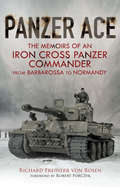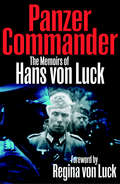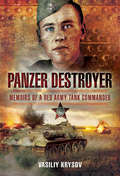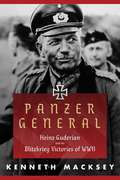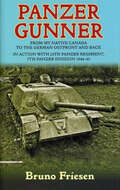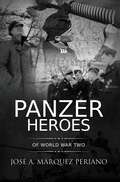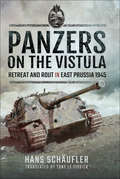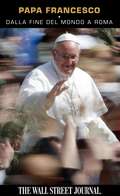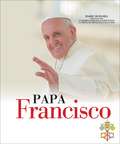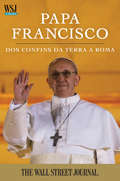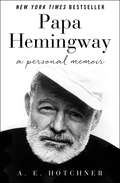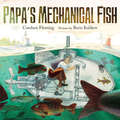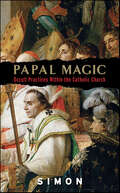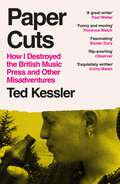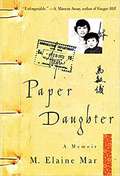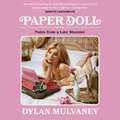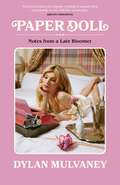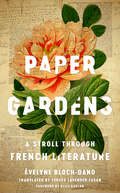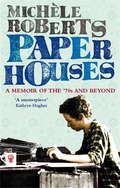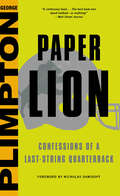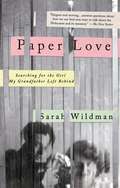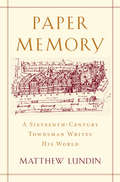- Table View
- List View
Panzer Ace: The Memoirs of an Iron Cross Panzer Commander from Barbarossa to Normandy
by Richard Freiherr von RosenA richly illustrated memoir by highly decorated Wehrmacht soldier—&“recommended to anyone with an interest in the Panzerwaffe in the Second World War&” (Recollections of WWII). After serving as a gunlayer on a Pz.Mk.III during Barbarossa, Richard Freiherr von Rosen led a Company of Tigers at Kursk. Later he led a company of King Tiger panzers at Normandy and in late 1944 commanded a battle group (12 King Tigers and a flak Company) against the Russians in Hungary in the rank of junior, later senior lieutenant (from November 1944, his final rank.) Only 489 of these King Tiger tanks were ever built. They were the most powerful heavy tanks to see service, and only one kind of shell could penetrate their armor at a reasonable distance. Every effort had to be made to retrieve any of them bogged down or otherwise immobilized, which led to many towing adventures. The author has a fine memory and eye for detail. Easy to read and not technical, his account adds substantially to the knowledge of how the German Panzer Arm operated in the Second World War. &“The author has a fine memory and eye for detail . . . It adds substantially to the knowledge of how the German Panzer Arm operated during the Second World War.&”—Military Vehicles Magazine &“The images accompany the story well. Richard Von Rosen, wounded several times and fighting a good part of the war on the eastern front, was certainly a lucky soldier, and we are also lucky to read these pages . . . highly recommend to all fans of memories of the Second World War.&”—Old Barbed Wire Blog
Panzer Commander: The Memoirs of Hans von Luck (Cassell Military Paperbacks Ser.)
by Hans von Luck&“This unique memoir tells the story of one of the field-grade officers whose martial skills sustained the Third Reich against a world in arms.&”—Library Journal Panzer Commander is one of the classic memoirs of the Second World War. A professional soldier, Hans von Luck joined the Panzerwaffe in its earliest days, where he served under Erwin Rommel, and went on to fight in the Blitzkrieg in Poland, France and the Soviet Union. He then served with the Afrika Korps in the Western Desert and tells of the sometimes chivalrous relationship with the British 8th Army. After the collapse in Africa, he returned to Europe and fought throughout the Normandy campaign and was responsible for the failure of the British breakout attempt, Operation Goodwood. He then took part in the final desperate battles on the Eastern Front. Captured by the Soviets at the end of the war, he was held for five years in a prison camp in the Caucasus. After the war, he formed friendships with those who had been his opponents during it, including Major John Howard, who had led the capture of Pegasus Bridge in Normandy. With a new preface by the author&’s widow, this unique and valuable account of one man&’s war and its aftermath is required reading for all those interested in the Second World War. &“One of the few books that MUST be part of any library . . . It is vivid and engaging. It paints the finest of verbal pictures and it does so without demonstrations of ego . . . it is one of the building blocks of knowledge that creates the palace of history.&”—Firetrench
Panzer Destroyer: Memoirs of a Red Army Tank Commander
by Vasiliy KrysovIn this military memoir, a Soviet Red Army officer recounts his experience fighting against Nazi Germany along the Eastern Front in World War II. The day after Vasiliy Krysov finished school, on June 22, 1941, Germany attacked the Soviet Union and provoked a war of unparalleled extent and cruelty. For the next three years, as a tank commander, Krysov fought against the German panzers in some of the most intense and destructive armored engagements in history, including those at Stalingrad, Kursk, and Knigsberg. This is the remarkable story of his war. As the commander of a heavy tank, a self-propelled gun—a tank destroyer—and a T-34, he fought his way westward across Russia, the Ukraine, and Poland against a skillful and determined enemy that had previously never known defeat. Krysov repeatedly faced tough SS panzer divisions, like the SS Leibstandarte Adolf Hitler Panzer Division in the Bruilov-Fastov area in 1943, and the SS Das Wiking Panzer Division in Poland in 1944. Krysov was at Kursk and participated in a counterattack at Ponyri. The ruthlessness of this long and bitter campaign is vividly depicted in his narrative, as is the enormous scale and complexity of the fighting. Honestly, and with an extraordinary clarity of recall, he describes confrontations with German Tiger and Panther tanks and deadly anti-tank guns. He was wounded four times, his crewmen and his commanding officers were killed, but he was fated to survive and record his experience of combat. His memoirs give a compelling insight into the reality of tank warfare on the Eastern Front.
Panzer General: Heinz Guderian and the Blitzkrieg Victories of WWII (Greenhill Military Paperback Ser.)
by Kenneth MackseyKenneth Macksey’s highly regarded biography of Generaloberst Heinz Guderian gives clear insight into the mind and motives of the father of modern tank warfare. Panzer General shows Guderian as a man of ideas equipped with the ability to turn inspiration into reality. A master of strategy and tactics, he was the officer most responsible for creating blitzkrieg in World War II. Guderian built the Panzerwaffe in the face of opposition from the German General Staff and personally led the lightning campaigns by tanks and aircraft that put a large part of Europe under domination by the Third Reich. Kenneth Macksey, a tank man himself for more than twenty years, reveals the man as a brilliant rebel in search of ideals and a general whose personality, genius, and achievements far transcended those of Rommel. As well as throwing light on the crucial campaigns in Poland, France, and Russia, this biography illuminates the struggles within the German hierarchy, both in the military and in the Nazi Party, for control of the Panzer forces. Based on information from the extensive family archives, Panzer General demonstrates why Guderian was so admired by some while denigrated by others.
Panzer Gunner: From My Native Canada to the German Osfront and Back. In Action with 25th Panzer Regiment, 7th Panzer Division 1944-45
by Bruno FriesenAn insider’s account of training and service in Nazi Germany’s twenty-fifth Panzer Regiment during World War II.There are few memoirs available of German Panzer crews that focus on the climactic last 12 months of the war on the Eastern Front, 1944-45. What makes Bruno Friesen's account virtually unique is his family background: his parents came from a German-speaking Mennonite community in Ukraine, and were to all intents and purposes culturally German. To make matters even more complex, in 1924 his parents left the Ukraine for Canada, where Bruno was born. In March 1939 he and his brother Oscar found themselves on a ship bound for Bremerhaven in Germany. He barely spoke German, and had never been to Germany, nevertheless his father envisaged that a better life awaited them in the Third Reich.Needless to say, Bruno became caught up in the Second World War, and in 1942 was drafted into the Wehrmacht. The author provides a full account of his family background, and how, through these unusual circumstances, he found himself a Canadian-born German soldier.The bulk of the book is a detailed account of the author’s training, and his subsequent service with 25th Panzer Regiment, part of 7th Panzer Division. As the title suggests, Bruno Friesen served as a gunner aboard, initially, Panzer IVs, before crewing the lesser-known Jagdpanzer IV tank hunter. The author provides a fantastic amount of information about these two vehicles, and how the crews actually fought in battle with them. This kind of 'hands-on' detail has almost never been available before, particularly such extensive information concerning the characteristics and combat performance of the Jagdpanzer IV.Apart from providing a large fund of information about specific German tanks and their combat performance, the author writes in great detail about the combat the experienced on the Eastern Front, including tank battles in Rumania, spring 1944, Lithuania in the summer of 1944, and West Prussia during early 1945. If one wants to know how German tank crews fought the Soviets in the last year of the war, then this book provides an outstanding account, containing material simply not found elsewhere.The author closes his account by reflecting on his post-war efforts to return to Canada, which eventually succeeded in 1950, and his subsequent life there.This book is not just a critique of armored fighting vehicles and tank warfare, it is above all a very human story, told in a lively, conversational and fluid manner, and is a remarkable contribution to the literature of the Second World War.
Panzer Heroes of World War II: [N.A.] ([N.A.] #1)
by José A. Márquez PerianoHistory of the most highly decorated military personnel of the armored forces of the Third Reich.
Panzers on the Vistula: Retreat and Rout in East Prussia 1945
by Hans SchäuflerThis WWII memoir of a Nazi officer is one of the most revealing firsthand accounts of the German retreat on the Eastern Front. A second lieutenant of the 4th Panzer division, Hans Schäufler commanded a Jagdpanther tank destroyer in rearguard actions against the Red Army in East Prussia in 1945. Then, as an infantryman, he took part in the doomed defense of Danzig before escaping across the Baltic in a small boat. His personal story offers a rare glimpse into the chaos and suffering endured by tens thousands of soldiers and civilians during the collapse of the Third Reich in the east. Along with vivid descriptions of the appalling conditions in Danzig and the fear and panic that gripped the city, Schäufler&’s account provides valuable insight into the German army&’s tactics as they fell back before the Soviet advance. While acute shortages of men, equipment, ammunition and fuel crippled the defense, the soldiers went on fighting for a lost cause in the face of certain defeat.
Papa Francesco
by The Wall Street JournalIl 13 Marzo, i cardinali della Chiesa Cattolica, riunitisi per la prima volta in 600 anni per eleggere il successore di un Papa ancora vivente, hanno annunciato un incredibile cambiamento. Nel promuovere il Cardinale argentino Jorge Mario Bergoglio a diventare Papa Francesco, il 266 Pontefice, i cardinali hanno eletto per la prima volta un Papa venuto dal Nuovo Mondo in via di sviluppo per prendere il timone della chiesa in un momento cruciale. E stato un cambiamento sorprendente in 2000 anni di istituzione che ha avuto larga influenza - con 1. 2 miliardi di fedeli in tutto il mondo - ed enormi problemi, tra cui uno scandalo di decennali abusi sessuali che ha distrutto la fede nellistituzione, una mancanza di preti e tendenze secolari che hanno svuotato la chiesa di membri e messo alla prova la sua autorita in un mondo votato al cambiamento. Dalla sconvolgente decisione di dimettersi di Papa Benedetto XVI alla nomina di Papa Francesco, dalle strade secondarie di Buenos Aires alla prima fila in Piazza San Pietro, i giornalisti di The Wall Street Journal hanno raccontato queste drammatiche settimane nella vita dellistituzione piu antica al mondo. Ora, con un nuovo e-book, gli inviati del Giornale presenteranno una dettagliata biografia originale e tempestiva del nuovo Papa Francesco, cosi come una nuova visione sulla trattativa e sul dramma che ha accompagnato la sua ascesa. Papa Francesco rappresentera a fondo lintera storia del cambiamento di direzione della chiesa e luomo incaricato di guidarla e sara da valutare come Papa Francesco potrebbe affrontare gli anni di scandalo e le carenze mentre guida i cattolici di tutto il mondo verso una fede piu profonda. The Wall Street Journal e il quotidiano piu importante dAmerica con una tiratura totale media di circa 2. 3 milioni di abbonati e 36 milioni al mondo di lettori digitali ogni mese. Negli ultimi anni il Journal ha ampliato i suoi argomenti di base dando spazio alle arti, alla cultura, ai costumi, allo sport e alla salute, aggiungendoli al suo patrimonio di fonte principale di notizie finanziarie ed economiche. In quanto uno dei piu grandi giornali mondiali che raggruppa lattivita di 2000 giornalisti in oltre 50 paesi, e arrivato ora ad otto edizioni in 11 lingue, coinvolgendo i lettori tramite i quotidiani, i siti web, le riviste, i social media e i video. Il Journal ha ottenuto 34 Premi Pulitzer per leccezionale attivita giornalistica.
Papa Francisco
by Marie DuhamelDesde el momento en que fue elegido para el papado, el papa Francisco ha captado la atención del mundo con su humildad, carisma y espíritu reformistaEsta biografía ilustrada única del primer Papa jesuita ofrece más de 250 fotografías e incluye 50 documentos de la vida de Francisco que se pueden extraer del libro. Escrita por la reportera de Radio Vaticano, Marie Duhamel, este retrato íntimo incluye la emigración de sus padres desde Italia, su nacimiento como Jorge Mario Bergoglio en 1936, su amor por el fútbol y la ópera cuando era niño, la neumonía que casi le costó la vida cuando era un adulto joven, su llamado al sacerdocio, y su primer encuentro con la pobreza cuando era misionero en Chile que cambió su vida. Duhamel hace una crónica del ascenso de Francisco de sacerdote a obispo, de cardenal al papado, y cómo, a lo largo del camino, impresionó a muchas personas, y alejó a algunas, con su valentía para hacer frente a la autoridad y su dedicación a ayudar a los pobres. Los documentos adjuntos, como su certificado de bautismo, fotografías de su niñez, páginas de un cuaderno escolar, notas manuscritas como Papa, e incluso una tarjeta de seguidor de su querido club de fútbol del San Lorenzo, ilustran más aún su vida y crean un recuerdo duradero de este Papa para el pueblo.---From the moment he was elected into the papacy, Pope Francis has captured the attention of the world with his humility, charisma, and reformist spirit. This one-of-a-kind, illustrated biography of the first Jesuit pope offers more than 250 photographs and 50 documents from Francis's life. Written by Vatican Radio reporter Marie Duhamel, this intimate portrait includes his parents emigration from Italy, his birth as Jorge Mario Bergoglio in 1936, his love of soccer and opera as a child, the pneumonia that nearly cost him his life as a young adult, his calling to the priesthood, and his first encounter with poverty as a missionary in Chile that would change his life. Duhamel chronicles Francis's rise from priest to bishop to cardinal to the papacy and how, along the way, he impressed many people-and alienated some-with his courage to stand up to authority and his dedication to helping the poor. Enclosed documents such as his baptism certificate, photographs from his childhood, pages from a school notebook, handwritten notes as pope, and even a support card for his beloved San Lorenzosoccer club, further illuminate his life and create a lasting keepsake of this pope of the people.
Papa Francisco
by The Wall Street JournalEm 13 de março, os cardeais da Igreja Católica, reunidos para eleger um sucessor de um Papa ainda vivo pela primeira vez em 600 anos, anunciaram uma mudança dramática. Ao eleger o cardeal Jorge Mario Bergoglio da Argentina como Papa Francisco 266°, os cardeais nomeavam o primeiro Papa do emergente Novo Mundo em toda história, para assumir a liderança da Igreja em um momento crucial. Esta foi uma mudança impressionante feita por uma instituição de 2000 anos de idade que tem imensa influência -- com 1.2 bilhões de seguidores em todo mundo -- e enormes problemas, incluindo um escândalo de abuso sexual que perdura por uma década e abalou a fé na instituição, escassez de padres e tendências seculares, que fizeram a Igreja perder membros e colocaram à prova sua relevância em um mundo em transformação. Desde a surpreendente decisão do Papa Bento XVI de se aposentar, até a apresentação do Papa Francisco, das tranquilas ruas de bairro de Buenos Aires até a primeira fila da praça de São Pedro, os repórteres do Wall Street Journal registraram essas dramáticas semanas na vida da mais antiga instituição do mundo. Agora, em um novo e-book, os repórteres do Journal irão apresentar uma biografia detalhada, original e oportuna do novo Papa Francisco, bem como novas visões das negociações e do drama que cercaram sua acensão. Papa Francisco irá apresentar a história completa e aprofundada da mudança de direção da Igreja e do homem encarregado de liderá-la, e analisar como o Papa Francisco poderá lidar com anos de escândalo e deficiência, enquanto lidera os católicos de todo o mundo em direção a uma fé mais profunda. The Wall Street Journal é o maior jornal dos Estados Unidos, considerando a circulação média total, com quase 2.3 milhões de assinantes e 36 milhões de visitantes digitais de todo o mundo por mês. Nos últimos anos, o Journal expandiu o seu conteúdo central para incluir a cobertura de arte, cultura, estilo de vida, esportes e saúde, tendo como base sua tradição como fonte principal de notícias financeiras e de negócios. Como uma das maiores operações de captação de notícias do mundo com 2.000 jornalistas em mais de 50 países, a franquia Journal abrange atualmente oito edições em 11 línguas, envolvendo leitores através de jornais, websites, revistas, mídia social e vídeos. O Journal detém 34 prêmios Pulitzer pela sua excelência em jornalismo.
Papa Hemingway: A Personal Memoir
by A. E. HotchnerAn intimate, joy-filled portrait and New York Times bestseller, written by one of Hemingway’s closest friends: “It is hard to imagine a better biography” (Life). In 1948, A. E. Hotchner went to Cuba to ask Ernest Hemingway to write an article on “The Future of Literature” for Cosmopolitan magazine. The article never materialized, but from that first meeting at the El Floridita bar in Havana until Hemingway’s death in 1961, Hotchner and the Nobel and Pulitzer Prize–winning author developed a deep and abiding friendship. They caroused in New York City and Rome, ran with the bulls in Pamplona, hunted in Idaho, and fished the waters off Cuba. Every time they got together, Hemingway held forth on an astonishing variety of subjects, from the art of the perfect daiquiri to Paris in the 1920s to his boyhood in Oak Park, Illinois. Thankfully, Hotchner took it all down. Papa Hemingway provides fascinating details about Hemingway’s daily routine, including the German army belt he wore and his habit of writing descriptive passages in longhand and dialogue on a typewriter, and documents his memories of Gertrude Stein, F. Scott Fitzgerald, Martha Gellhorn, Marlene Dietrich, and many of the twentieth century’s most notable artists and celebrities. In the literary icon’s final years, as his poor health began to affect his work, Hotchner tenderly and honestly portrays Hemingway’s valiant attempts to beat back the depression that would lead him to take his own life. Deeply compassionate and highly entertaining, this “remarkable” New York Times bestseller “makes Hemingway live for us as nothing else has done” (The Wall Street Journal).
Papa John: The Autobiography Of John Phillips
by John Phillips Jim JeromeSex, drugs, and rock 'n ' roll. It was the anthem of the sixties. The psychedelic code by which many lived --and died. And John Phillips, legendary founder and songwriter of the Mamas and the Papas, experienced it all. Now Phillips takes us on a dizzying roller-coaster ride from stardom in L.A. to drug busts in the Big Apple. In an intimate, gritty, all- too-true self-portrait, he offers a startling, reflective look at the turbulent sixties and beyond.
Papa's Mechanical Fish
by Candace FlemingCandace Fleming and illustrator Boris Kulikov pair up to tell a fun story about a real submarine inventor in Papa's Mechanical FishClink! Clankety-bang! Thump-whirr! That's the sound of Papa at work. Although he is an inventor, he has never made anything that works perfectly, and that's because he hasn't yet found a truly fantastic idea. But when he takes his family fishing on Lake Michigan, his daughter Virena asks, "Have you ever wondered what it's like to be a fish?"—and Papa is off to his workshop. With a lot of persistence and a little bit of help, Papa—who is based on the real-life inventor Lodner Phillips—creates a submarine that can take his family for a trip to the bottom of Lake Michigan.
Papal Magic: Occult Practices Within the Catholic Church
by SimonIt is acknowledged Church doctrine that sorcery is the specific domain of the Devil. Yet occult tales are liberally sprinkled throughout the Old and New Testaments, from the spirit-invoking Witch of Endor to the story of Jesus raising Lazarus from the dead. Throughout its 2,000 year history, the Church has spawned numerous mystical religious orders, like the Knights Templar, that may have been engaged in supernatural pursuits, while no fewer than three popes were believed to be involved in occult practices.Christian scriptures tell us that the occult is real, while Catholic priests are thought to have spiritual power over ghosts and evil entities. But if a priest can cast out demons during the rites of exorcism, does it not imply he has the ability to summon them as well?In this eye-opening, provocative work, leading occult scholar Simon examines the Church's unspoken relationship with forbidden magic by exploring the infamous seventeenth-century document considered by some to be the most demonic of all occult texts—the Grimoire of Pope Honorius III—and illuminates the Vatican's darkest hidden corners.
Paper Cuts: How I Destroyed the British Music Press and Other Misadventures
by Ted Kessler'A great writer' Paul Weller'A music journalist of integrity' Billy Childish'There's only one Ted Kessler!' Liam GallagherPAPER CUTS is the inside story of the slow death of the British music press. But it's also a love letter to it, the tale of how music magazines saved one man's life. Ted Kessler left home and school around his seventeenth birthday, determined 'to be someone who listened to music professionally'. That dream appeared forlorn when he was later arrested for theft behind the counter of the record shop he managed during acid house's long hot summer of love. Paper Cuts tells how Kessler found redemption through music and writing and takes us on a journey alongside the stars he interviewed and the work-place dramas he navigated as a senior staffer at NME through the boom-time '90s and on to the monthly Q in 2004, where he worked for sixteen years before it folded with him at its helm as editor in 2020.We travel in time alongside musical heroes Paul Weller, Kevin Rowland, Mark E Smith, and to Cuba twice, first with Shaun Ryder and Bez, then with Manic Street Preachers. We spend long, mad nights out with Oasis and The Strokes, quality time with Jeff Buckley and Florence Welch, and watch Radiohead deliver cold revenge upon Kessler in public. A story about love and death, about what it's like when a music writer shacks up with a conflict of interest, and what happens when your younger brother starts appearing on the cover of the magazines you work for, this is the memoir of "a delinquent doofus" whose life was both rescued and defined by music magazines.
Paper Cuts: How I Destroyed the British Music Press and Other Misadventures
by Ted Kessler'A great writer' Paul Weller'A music journalist of integrity' Billy Childish'There's only one Ted Kessler!' Liam GallagherPAPER CUTS is the inside story of the slow death of the British music press. But it's also a love letter to it, the tale of how music magazines saved one man's life. Ted Kessler left home and school around his seventeenth birthday, determined 'to be someone who listened to music professionally'. That dream appeared forlorn when he was later arrested for theft behind the counter of the record shop he managed during acid house's long hot summer of love. Paper Cuts tells how Kessler found redemption through music and writing and takes us on a journey alongside the stars he interviewed and the work-place dramas he navigated as a senior staffer at NME through the boom-time '90s and on to the monthly Q in 2004, where he worked for sixteen years before it folded with him at its helm as editor in 2020.We travel in time alongside musical heroes Paul Weller, Kevin Rowland, Mark E Smith, and to Cuba twice, first with Shaun Ryder and Bez, then with Manic Street Preachers. We spend long, mad nights out with Oasis and The Strokes, quality time with Jeff Buckley and Florence Welch, and watch Radiohead deliver cold revenge upon Kessler in public. A story about love and death, about what it's like when a music writer shacks up with a conflict of interest, and what happens when your younger brother starts appearing on the cover of the magazines you work for, this is the memoir of "a delinquent doofus" whose life was both rescued and defined by music magazines.
Paper Daughter: A Memoir
by M. Elaine MarWhen she was five years old, M. Elaine Mar and her mother emigrated from Hong Kong to Denver to join her father in a community more Chinese than American, more hungry than hopeful. While working with her family in the kitchen of a Chinese restaurant and living in the basement of her aunt's house, Mar quickly masters English and begins to excel in school. But as her home and school life--Chinese tradition and American independence--become two increasingly disparate worlds, Mar tries desperately to navigate between them. Adolescence and the awakening of her sexuality leave Elaine isolated and confused. She yearns for storebought clothes and falls for a red-haired boy who leads her away from the fretful eyes of her family. In his presence, Elaine is overcome by the strength of her desire--blocking out her family's visions of an arranged marriage in Hong Kong. From surviving racist harassment in the schooIyard to trying to flip her straight hair like Farrah Fawcett, from hiding her parents' heritage to arriving alone at Harvard University, Mar's story is at once an unforgettable personal journey and an unflinching, brutal look at the realities of the American Dream.
Paper Doll: Notes From A Late Bloomer
by Dylan Mulvaney'AN ESSENTIAL READ FOR ANYONE WITH A HEART' JOE LOCKE, star of Heartstopper'SHOULD BE REQUIRED READING FOR ANYONE LOOKING TO EXPAND THEIR RELATIONSHIP TO THE LGBTQ+ COMMUNITY' Kristin Chenoweth'DYLAN MAKES ME LAUGH AND MAKES ME BRAVE. I LOVE PAPER DOLL AND I LOVE THIS WOMAN' Glennon Doyle, #1 Sunday Times bestselling author of UntamedWhen Dylan Mulvaney came out as a woman online, she was a viral sensation almost overnight, emerging as a trailblazing voice on social media. Dylan's personal coming-out story blossomed into a platform for advocacy and empowerment for trans people all over the world.Through her "Days of Girlhood" series, she connected with followers by exploring what it means to be a girl, from experimenting with makeup to story times to spilling the tea about laser hair removal, while never shying away from discussing the transphobia she faced online. Nevertheless, she was determined to be a beacon of positivity.But shortly after she celebrated day 365 of being a girl, it all came screeching to a halt when an innocuous post sparked a media firestorm and right-wing backlash she couldn't have expected. Despite the vitriolic press and relentless paparazzi, Dylan was determined to remain loud and proud.In Paper Doll: Notes from a Late Bloomer, Dylan pulls back the curtain of her "It Girl" lifestyle with a witty and intimate reflection of her life pre- and post-transition. She covers everything from her first big break in theatre to the first time her dad recognized her as a girl to how she handled scandals, cancellations, and . . . tucking. It's both laugh-out-loud funny and powerfully honest-and is a love letter to everyone who stands up for queer joy.
Paper Doll: Notes From A Late Bloomer
by Dylan MulvaneyWhen Dylan Mulvaney came out as a woman online, she was a viral sensation almost overnight, emerging as a trailblazing voice on social media. Dylan's personal coming-out story blossomed into a platform for advocacy and empowerment for trans people all over the world. <p> Through her "Days of Girlhood" series, she connected with followers by exploring what it means to be a girl, from experimenting with makeup to story times to spilling the tea about laser hair removal, while never shying away from discussing the transphobia she faced online. Nevertheless, she was determined to be a beacon of positivity. But shortly after she celebrated day 365 of being a girl, it all came screeching to a halt when an innocuous post sparked a media firestorm and right-wing backlash she couldn't have expected. <p> Despite the vitriolic press and relentless paparazzi, Dylan was determined to remain loud and proud. In Paper Doll: Notes from a Late Bloomer, Dylan pulls back the curtain of her "It Girl" lifestyle with a witty and intimate reflection of her life pre- and post-transition. She covers everything from her first big break in theatre to the first time her dad recognized her as a girl to how she handled scandals, cancellations, and . . . tucking. It's both laugh-out-loud funny and powerfully honest-and is a love letter to everyone who stands up for queer joy. <b>New York Times Bestseller</b>
Paper Gardens: A Stroll through French Literature
by Evelyne Bloch-DanoFrom Jean-Jacques Rousseau to Marcel Proust, from Marguerite Duras to George Sand, from Colette to Patrick Modiano, gardens appear in novels as representations of the real world, but also as reflections of the imagination. In Paper Gardens: A Stroll through French Literature, Évelyne Bloch-Dano contemplates the role of the garden in the work of great prose writers, ruminating on how the garden can variously symbolize a reflection of the soul, a well-earned rest, an improving form of work, a nostalgia for childhood, and the dream of an ideal world. The charming and erudite first section focuses on history and is devoted to types of gardens ranging from the biblical Garden of Eden to English parklands; the second perceptively considers their role in literary works. Concealed within these cultivated wanderings is also an element of autobiography. Lovers of literature and gardening alike will fall in love with this beautifully written meditation.
Paper Houses: A Memoir of the 70s and Beyond
by Michele RobertsRebellion, revolution, experimental living, feminist communes, street theatre, radical magazines, love affairs - gay and straight - sex, drugs and rock and roll.Michèle Roberts, one of Britain's most talented and highly acclaimed novelists, now considers her own life, in this vibrant, powerful portrait of a time and place: alternative London of the 1970s and beyond. A fledgling writer taking a leap into radical politics, Roberts finds alternative homes, new families and lifelong friendships in the streets and houses of Holloway, Peckham, Regent's Park and Notting Hill Gate. From Spare Rib to publishing her first book, Paper Houses is Roberts' story of finding a space in which to live, love and write - and learning to share it.'Beguiling, enthusiastic, charming and vivid, this is an autobiography to be savoured' Amanda Craig, DAILY TELEGRAPH
Paper Houses: A Memoir of the 70s and Beyond
by Michele RobertsRebellion, revolution, experimental living, feminist communes, street theatre, radical magazines, love affairs - gay and straight - sex, drugs and rock and roll.Michèle Roberts, one of Britain's most talented and highly acclaimed novelists, now considers her own life, in this vibrant, powerful portrait of a time and place: alternative London of the 1970s and beyond. A fledgling writer taking a leap into radical politics, Roberts finds alternative homes, new families and lifelong friendships in the streets and houses of Holloway, Peckham, Regent's Park and Notting Hill Gate. From Spare Rib to publishing her first book, Paper Houses is Roberts' story of finding a space in which to live, love and write - and learning to share it.'Beguiling, enthusiastic, charming and vivid, this is an autobiography to be savoured' Amanda Craig, DAILY TELEGRAPH
Paper Lion: Confessions of a Last-String Quarterback
by Nicholas Dawidoff George PlimptonThe book that made a legend--and capture's America's sport in detail that's never been matched, now featuring a foreword by Nicholas Dawidoff a and never-before-seen content from the Plimpton Archives. George Plimpton was perhaps best known for PAPER LION, the book that set the bar for participatory sports journalism. With his characteristic wit, Plimpton recounts his experiences in talking his way into training camp with the Detroit Lions, practicing with the team, and taking snaps behind center. His breezy style captures the pressures and tensions rookies confront, the hijinks that pervade when sixty high-strung guys live together in close quarters, and a host of football rites and rituals. One of the funniest and most insightful books ever written on football, PAPER LION is a classic look at the gridiron game and a book The Wall Street Journal calls "a continuous feast...The best book ever about football--or anything!"
Paper Love
by Sarah WildmanOne woman's journey to find the lost love her grandfather left behind when he fled pre-World War II Europe, and an exploration into family identity, myth, and memory. Years after her grandfather's death, journalist Sarah Wildman stumbled upon a cache of his letters in a file labeled "Correspondence: Patients A-G." What she found inside weren't dry medical histories; instead what was written opened a path into the destroyed world that was her family's prewar Vienna. One woman's letters stood out: those from Valy--Valerie Scheftel. Her grandfather's lover who had remained behind when he fled Europe six months after the Nazis annexed Austria. Valy's name wasn't unknown to her--Wildman had once asked her grandmother about a dark-haired young woman whose images she found in an old photo album. "She was your grandfather's true love," her grandmother said at the time, and refused any other questions. But now, with the help of the letters, Wildman started to piece together Valy's story. They revealed a woman desparate to escape and clinging to the memory of a love that defined her years of freedom. Obsessed with Valy's story, Wildman began a quest that lasted years and spanned continents. She discovered, to her shock, an entire world of other people searching for the same woman. On in the course of discovering Valy's ultimate fate, she was forced to reexamine the story of her grandfather's triumphant escape and how this history fit within her own life and in the process, she rescues a life seemingly lost to history.
Paper Memory: A Sixteenth-Century Townsman Writes His World (Harvard historical studies ; #179)
by Matthew LundinPaper Memory tells of one man’s mission to preserve for posterity the memory of everyday life in sixteenth-century Germany. Lundin takes us inside the mind of an undistinguished German burgher, Hermann Weinsberg, whose early-modern writings sought to make sense of changes that were unsettling the foundations of his world.
